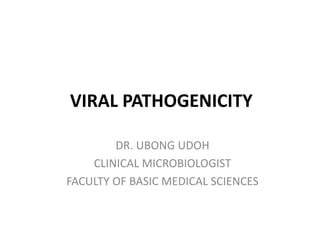
Viral Pathogenicity.pptx
- 1. VIRAL PATHOGENICITY DR. UBONG UDOH CLINICAL MICROBIOLOGIST FACULTY OF BASIC MEDICAL SCIENCES
- 2. Introduction • In order for an infection to occur, a virus must first replicate in a host. • Viral disease occurs as a result of the interaction between the virus and host factors. • Clinical disease occurs when a viral infection results in signs and symptoms, however most viral infections do not produce symptoms and are described as subclinical (inapparent) disease. • The same virus may produce a variety of diseases while the same disease may be produced by a variety of viruses.
- 3. Steps in viral pathogenesis • Entry of virus into the host. • Primary replication. • Viral spread. • Host defense response. • Shedding and transmission of infection. *it must first be virent measles is respiratory virus likes macrophage
- 4. Viral entry into host • Virus attaches to cells at one of the body surfaces (the skin, respiratory tract, gastrointestinal tract, urogenital tract or conjunctiva) and then enters. • Viruses may enter through virus contaminated -needles -therapeutic substances -blood or blood products • Also bites from insect vectors or sick animal (e.g. rabies) introduces virus into the host.
- 5. Replication • Viruses usually initiate infection by replicating at the portal of entry. • Respiratory viruses replicate in; epithelial cells lining the alveoli or respiratory tract phagocytic cells located either in the respiratory or sub epithelial spaces. • Some others replicate in the skin to produce local lesions e.g. Poxviruses, Papillomavirus
- 6. Steps in viral replication • Attachment: the virus attaches to the host cell using specialized attachment sites distributed over the surface of the virion to specific cellular receptors. • Penetration: commonly occurs by receptor mediated endocytosis and the virion contained within a cytoplasmic vacuole. • Uncoating: rearrangement of coat components, causing the extrusion of the viral core into host cell cytosol.
- 7. Steps in viral replication • Genome synthesis: virulent viruses shut off cellular protein synthesis and disaggregate cellular polyribosomes favouring a shift to viral synthesis using varied mechanisms. • Assembly: some viruses (herpesviruses) assemble in the nucleus while others assemble in the cytoplasm. Chaperones are involved. • Maturation: this proceeds differently for naked, enveloped and complex viruses.
- 9. Viral spread • Lymphatic: the first step in the dissemination of infection is the transport of virus via efferent lymphatic drainage from the primary site of infection to regional lymph nodes. • Neural: some viruses can spread along peripheral nerves. Through this route, Rabies virus reaches the brain to cause disease, and Herpes simplex virus reaches the ganglia to initiate latent infections.
- 10. Viral spread • Blood: Active viraemia; Primary viraemia: viruses from regional lymph nodes enter the bloodstream and are disseminated to the muscles, bone marrow, liver, spleen and blood vessels, where further replication takes place. Secondary viraemia: from the RES the viruses again enter the blood stream to reach their target organs. The viruses again replicate in these organs. Passive viraemia; following direct inoculation e.g. arthropod vectors, blood transfusion or I.V. drug abuse.
- 11. Host response to viral infection • Immunological Humoral (antibody-mediated) immunity- the production of immunoglobulins IgM, IgA and IgG play an important role in immunity to virus infection. They can directly affect virus infectivity by neutralizing the processes of attachment, entry and uncoating. Cell-mediated immunity-protects against those viral infections which are not associated with viraemia, but where the virus spreads from cell-to-cell by fusion with antigenic alterations to cell membranes e.g. Herpes or Paramyxoviruses.
- 12. Host response to viral infection • Immunological • Macrophages; recognize virus-infected cells and kill them (cytotoxic activity). They also kill cells coated with IgG antibodies by ADCC. • Lymphocytes (T-cells); Cytotoxic T-cells are generated in response to viral antigens on infected cells and kill the cells thereby preventing the spread of infection.
- 13. Host response to viral infection Helper T-cells are involved in generation of cytotoxic T-cells and in assisting B-cells to make antibody. In addition, lymphokines secreted by T-cells can recruit and activate macrophages and NK cells (which directly kill virally infected cells).
- 14. Host response to viral infection • Non-immunological: these are the early non- specific responses put up by the host and include general physiological defenses; – Inflammation – Phagocytosis – NK cells – Interferon – Complement – Pyrexia – Cytokines
- 15. Shedding & transmission of infection • This is the last step in viral pathogenesis and is imperative for the maintenance of a viral infection in a host population. • Most shedding usually occurs from the body surface utilized for the entry of viruses into the host. • Shedding occurs into respiratory aerosols, faeces, urine, blood, genital fluid and milk. • It is transmitted vertically (transplacentally) or horizontally to susceptible host. Shedding does not occur in infection of the brain. This is referred to as a dead-end infection.
- 16. Oncogenicity • The ability to induce malignant transformation of host cells. • Peyton Rous first demonstrated that viral infections can cause cancer. Oncogenic viruses cause cancer by altering normal cell growth through; Increasing saturation density Negating growth factor requirements Negating anchorage dependence
- 17. Viruses & associated malignancies • HPV- cervical cancer & anogenital neoplasms. • EBV- Burkitt’s lymphoma, Hodgkin’s disease, B-cell lymphoma & nasopharyngeal carcinoma. • Human herpesvirus 8- Kaposi sarcoma & primary effusion lymphoma in persons with HIV infection • HBV and HCV- hepatocellular carcinoma. • HTLV- Adult T-cell leukaemia. • HIV- AIDS related malignancies.
- 18. General oncogenic mechanisms • Persistence of infection. • Host immune response. • Viral oncogenic virulence. • Cell susceptibility to viral infection & transformation. • Retention of viral nucleic acid in host cell.
- 19. Conclusion